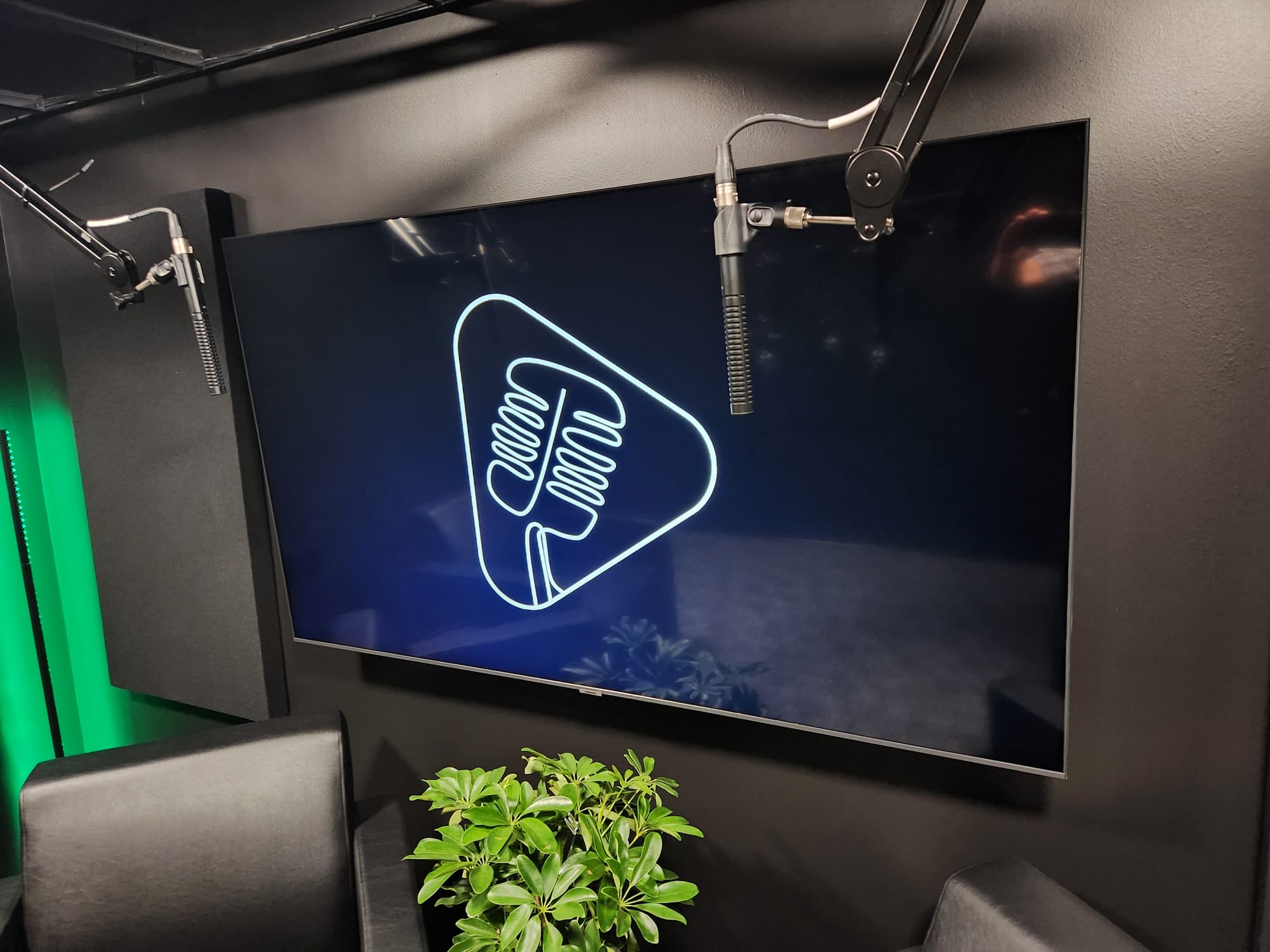A simple request generates a technical discussion on presentation techniques.

Sometimes discussion around the water cooler yields results. Several of us at PodcastVideos.com were batting around a customer request the other day, and now we’re going to share our insights with you. Call it accidental content generation.
THE SITUATION:
A host wants to incorporate a slideshow into his recording. He’s got the slides, and wants to meet before the session to arrange for them to pop up on the TV in the studio as he and his guest discuss them.
Both host and guest will be in the studio.
The television usually displays the show logo on a black background.
THE PROBLEMS:
Yeah, it’s problems, plural.
The first involves lighting. The studio in question has a 65-inch TV mounted opposite from the wide-angle camera, with hosts and guests at a rectangular conference table between. Lighting comes from one overhead lamp and four studio lights mounted high on the walls, one aimed at each of the four chair/mic spots. No problem so far….
But, the default setup for slides in most programs is black text on a white background, with color added in graphs, charts or other visual assets.
So, as you flip that TV from a show logo on black background to a 65-inch slide on white, that’s a massive rectangle of bright white light beaming out into your studio. It overpowers the lighting of the room, and washes out the slide info, the hosts and the studio background.
Second problem, the ‘flicker effect.” Even with high-end cameras, filming information off of television or computer screens creates an unwanted flickering sensation, blurring even simple, bold images in the recording. Smaller data - for example, a slide containing several charts and graphs - are simply unreadable.
THE SOLUTION
Exact solutions might differ, but our basic recommendation- don’t even try to put the slides up on the TV in the first place. Wait for the post production process, and insert them at that time.
We recommended that the host have his slide deck ready to pull up on laptops for both himself and the guest during recording. The computers are fairly unobtrusive in the studio, and they can see the datasets they will discuss. The viewers don’t need to see the data at this time.
After recording, send us the slide deck, which the editors can access and overlay as needed in the editing process. It’s sharper, cleaner, and easier for the viewer to see and absorb.
In a livestreaming situation, providing a producer with the slide deck and show notes or cues to pull them up will also work. Rather than push them through the television, a producer simply swaps video input from the studio cameras to the computer showing the slides, while keeping the studio audio of host/guest discussion. Sometimes a picture-in-picture set is utilized as well.
IF THE TV IS THE ONLY OPTION
Multiple inputs, producers, professional editors backing up the process…. Not every podcaster has those resources. If you’re operating on a basic setup, the TV might be your only way to project slides, pictures or other assets. There are a few tips to improve the quality of recording if you have to go this route. Practice and testing, of course, can help get you dialed in.
First, background and design. Use a black background for slides, with white text, to minimize the light blowout. Simplify your slide deck, with single features in large, bold print and basic colors for enhanced readability. Keep presentations short to minimize flicker.
Second, adjust the electronics, especially the TV. (Changing up camera settings is a last resort, as it can lead to other technical gremlins.) Brightness, contrast and sharpness can all be adjusted on any modern television, but if you can get into the advanced settings and play with the frames per second and/or refresh rate to match those on the recording camera, flicker and blowout can be reduced or eliminated. Remember to check this through the camera output, as the differences between the human and camera eye can only be identified from behind the lens.
CONCLUSION
As an outfit that offers professional editing, it might seem self-serving to recommend this route, but taking the TV out of the equation and adding presentation elements in post production will result in a far superior output. Absent that, a mix of research, preparation and tuning can help clean up a basic TV-based output.
And that, folks, is how we spent 15 minutes yesterday.